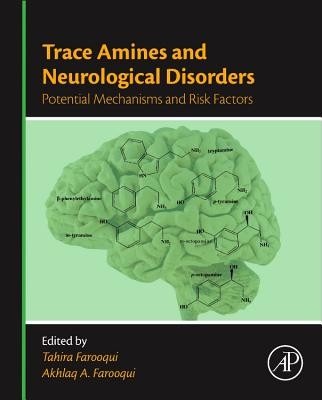
- We will send in 10–14 business days.
- Publisher: Academic Press
- ISBN-10: 0128036036
- ISBN-13: 9780128036037
- Format: 19.3 x 23.6 x 2.8 cm, hardcover
- Language: English
- SAVE -10% with code: EXTRA
Trace Amines and Neurological Disorders (e-book) (used book) | bookbook.eu
Reviews
Description
Trace Amines and Neurological Disorders: Potential Mechanisms and Risk Factors explores trace amines which, under normal conditions, are present in the mammalian brain and peripheral nervous tissues at very low (nanomolar) concentrations. However, in a diverse array of human pathologies ranging from substance abuse, depression, attention deficit hyperactivity disorder, eating disorders, schizophrenia, and other neurological and neuropsychiatric diseases, the levels of trace amines are unusually high with an imbalance in their functions. Furthermore, the rapid turnover of trace amines is evidenced by their dramatic increases following treatment with monoamine oxidase inhibitors (MAOI) or deletion of the MAO genes. This suggests that the concentration of trace amines may be considerably higher at neuronal synapses than predicted by steady-state measures, implicating some pathophysiological role. Therefore, understanding molecular mechanisms and developing selective agonists and antagonists for trace amine-associated receptors (TAARs) has become a good approach for treating these diseases. Although the effects of trace amines at low physiological concentrations in mammalian species have been difficult to demonstrate, they may serve to maintain the neuronal activity of other monoamine neurotransmitters by possessing postsynaptic modulatory effects, particularly dopamine and serotonin, within defined physiological limits. Such an effect of trace amines makes them ideal candidates for the development of novel therapeutics for a wide range of human disorders. This book presents up-to-date, cutting-edge, and comprehensive information on the link between trace amines and neurological disorders.
EXTRA 10 % discount with code: EXTRA
The promotion ends in 16d.18:29:57
The discount code is valid when purchasing from 10 €. Discounts do not stack.
- Publisher: Academic Press
- ISBN-10: 0128036036
- ISBN-13: 9780128036037
- Format: 19.3 x 23.6 x 2.8 cm, hardcover
- Language: English English
Trace Amines and Neurological Disorders: Potential Mechanisms and Risk Factors explores trace amines which, under normal conditions, are present in the mammalian brain and peripheral nervous tissues at very low (nanomolar) concentrations. However, in a diverse array of human pathologies ranging from substance abuse, depression, attention deficit hyperactivity disorder, eating disorders, schizophrenia, and other neurological and neuropsychiatric diseases, the levels of trace amines are unusually high with an imbalance in their functions. Furthermore, the rapid turnover of trace amines is evidenced by their dramatic increases following treatment with monoamine oxidase inhibitors (MAOI) or deletion of the MAO genes. This suggests that the concentration of trace amines may be considerably higher at neuronal synapses than predicted by steady-state measures, implicating some pathophysiological role. Therefore, understanding molecular mechanisms and developing selective agonists and antagonists for trace amine-associated receptors (TAARs) has become a good approach for treating these diseases. Although the effects of trace amines at low physiological concentrations in mammalian species have been difficult to demonstrate, they may serve to maintain the neuronal activity of other monoamine neurotransmitters by possessing postsynaptic modulatory effects, particularly dopamine and serotonin, within defined physiological limits. Such an effect of trace amines makes them ideal candidates for the development of novel therapeutics for a wide range of human disorders. This book presents up-to-date, cutting-edge, and comprehensive information on the link between trace amines and neurological disorders.


Reviews